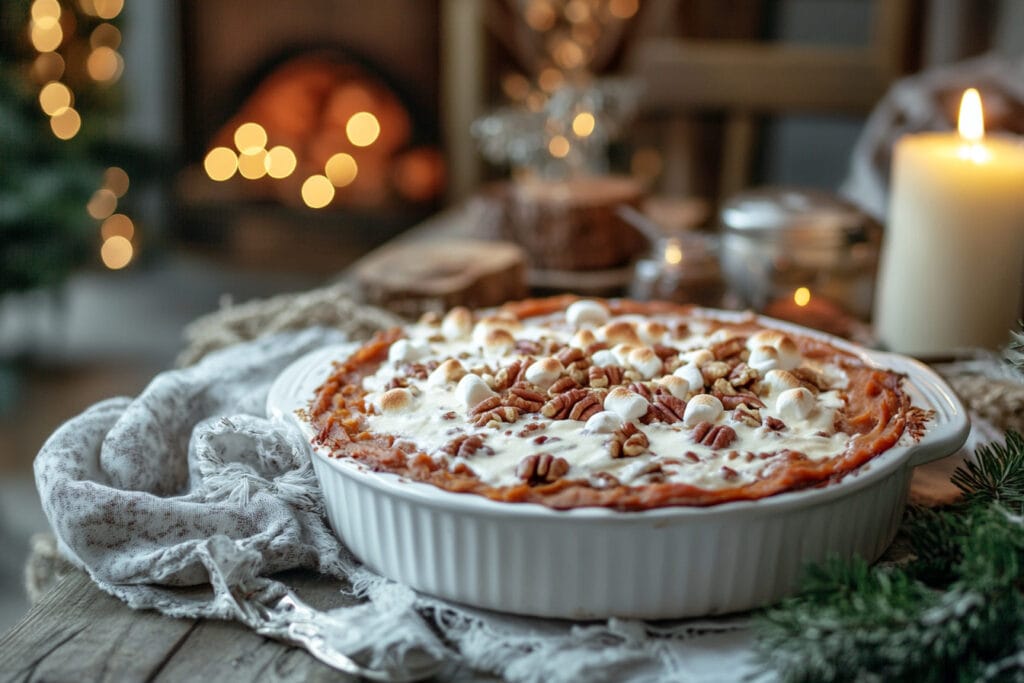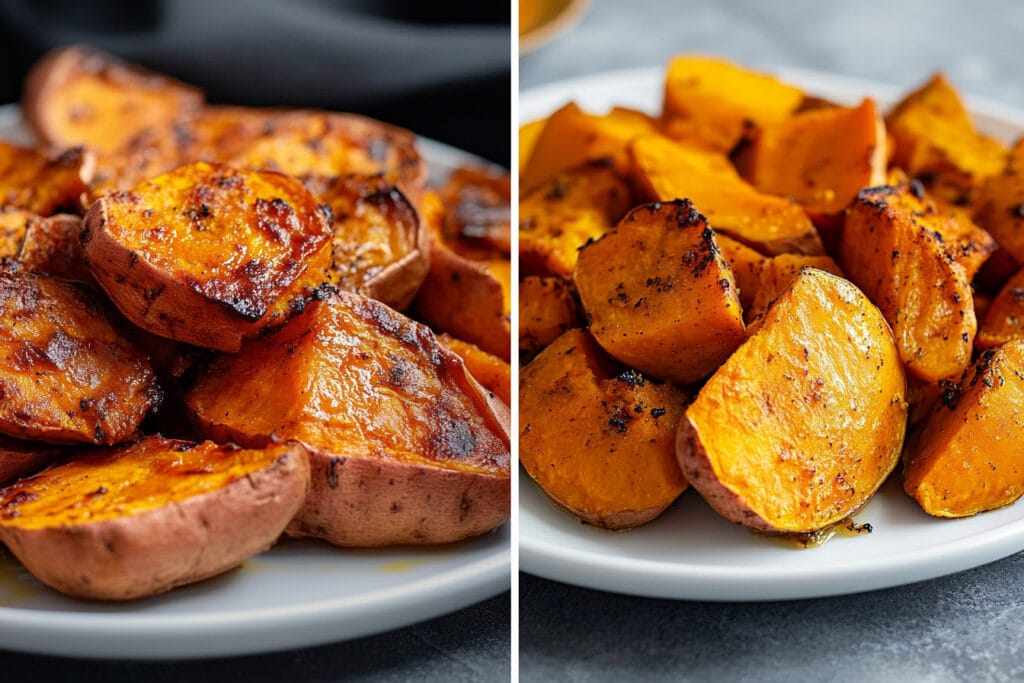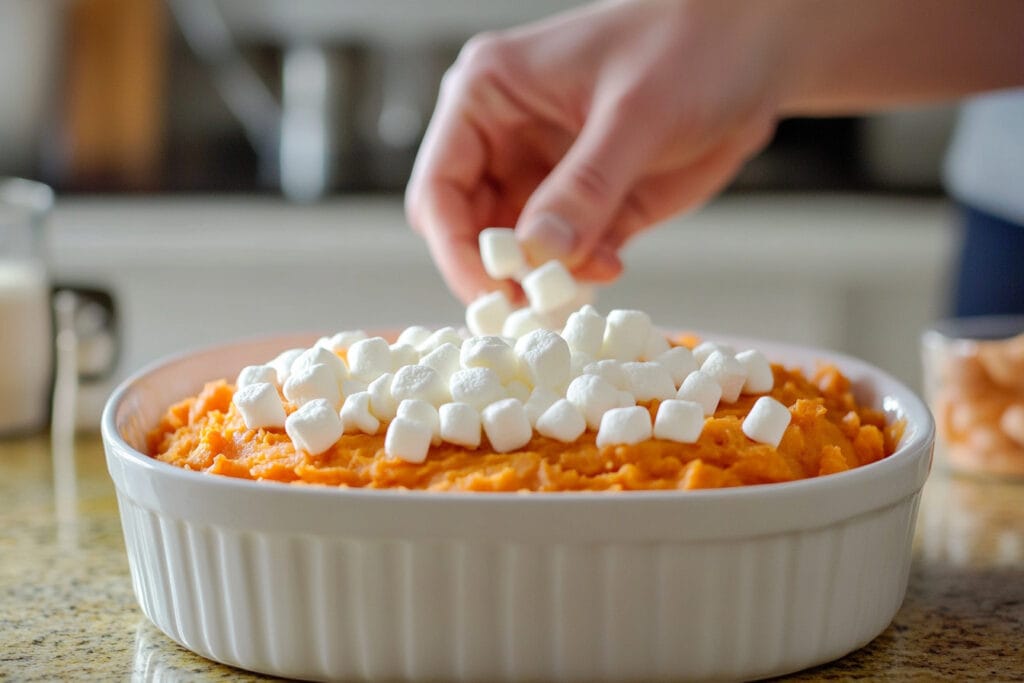
Sweet potato casserole is a beloved dish that many families enjoy, especially during holiday dinners. But if you’re planning to make this casserole, you may find yourself asking, “Is it better to bake or boil sweet potatoes for casserole?” While this might seem like a small detail, the way you cook sweet potatoes can greatly affect their texture, flavor, and nutritional value.
In this article, we’ll dive into the science and practicality behind baking and boiling sweet potatoes. You’ll discover which method might work better depending on the type of casserole you’re preparing, and how each method impacts the final dish. By the end, you’ll be able to make the best decision for your next sweet potato casserole, whether you want it creamy, chunky, or bursting with natural sweetness.
Understanding Sweet Potatoes
Sweet potatoes are not just any regular vegetable; they’re a powerhouse of flavor, nutrition, and versatility. Before diving into whether baking or boiling is better for a casserole, let’s first understand what makes sweet potatoes so unique and why they’re a favorite choice for casseroles.
What Are Sweet Potatoes?
Sweet potatoes are starchy root vegetables that belong to the morning glory family. While many people confuse them with yams, they are completely different! Sweet potatoes come in various types, with orange-fleshed ones being the most common. Other varieties include purple, white, and even reddish-skinned sweet potatoes.
What makes sweet potatoes special is their natural sweetness, which intensifies when cooked. This sweetness is why they are perfect for casseroles, desserts, and savory dishes alike. Plus, they’re loaded with vitamins like Vitamin A (great for your eyes and skin), Vitamin C (to boost your immune system), and fiber (to aid digestion).
Why Are Sweet Potatoes Popular in Casseroles?
Sweet potato casseroles have become a classic dish, especially in countries like the United States during Thanksgiving or Christmas. Why? Because they’re comforting, flavorful, and versatile. You can combine them with marshmallows for a sweet treat, nuts for some crunch, or savory spices like cinnamon and nutmeg for depth.
The texture of sweet potatoes is another reason they’re great for casseroles. When cooked, they can be mashed into a creamy consistency or sliced for layering. The choice of baking or boiling plays a key role in how sweet potatoes behave in the dish. Baking tends to bring out a richer, caramelized flavor, while boiling can soften them for smooth mashing.
Sweet potatoes are also great for students learning to cook. They’re easy to prepare, affordable, and hard to mess up! But mastering the right cooking method for your casserole can take your dish from good to absolutely delicious.
Baking Sweet Potatoes
Let’s explore one of the most popular methods for preparing sweet potatoes for casseroles: baking.
How to Bake Sweet Potatoes
Baking sweet potatoes is simple and rewarding. Here’s a step-by-step guide:
- Preheat your oven to 400°F (200°C).
- Wash your sweet potatoes thoroughly to remove any dirt.
- Use a fork to poke a few holes into the skin (this prevents them from exploding in the oven!).
- Place them on a baking sheet lined with foil or parchment paper.
- Bake for about 45–60 minutes, depending on their size. You’ll know they’re done when you can easily pierce them with a fork.
When baking for casseroles, you can peel the skin after baking to get a soft and naturally sweet base for mashing or slicing.
Pros of Baking for Casseroles
- Enhanced Flavor: Baking intensifies the natural sweetness of sweet potatoes, making them taste richer. This caramelization process happens because of the heat inside the oven.
- Preserved Nutrients: Baking helps retain more vitamins and minerals since the sweet potatoes are not submerged in water.
- Better Texture for Slicing: If you prefer a casserole with sweet potato slices instead of a mash, baking helps them hold their shape better.

Nutritional Changes When Baking
When you bake sweet potatoes, their glycemic index (a measure of how fast your body digests sugar) remains lower compared to boiling. This means the energy they provide is released more steadily, making baked sweet potatoes a healthier option for keeping your energy levels balanced.
However, baking takes longer than boiling, and it requires an oven. If you’re short on time or don’t have access to one, boiling might be the better option.
Boiling Sweet Potatoes
Boiling sweet potatoes is another common method, and it’s especially popular when you’re short on time or want a smoother texture.
How to Boil Sweet Potatoes
Boiling sweet potatoes is quick and easy. Follow these steps:
- Wash and peel your sweet potatoes (optional, as you can peel them after boiling too).
- Cut them into evenly sized chunks to ensure they cook faster and evenly.
- Place the pieces into a pot of water, making sure they’re fully covered.
- Add a pinch of salt to enhance the flavor.
- Boil the sweet potatoes for about 15–20 minutes, or until they’re fork-tender.
Once done, drain the water and let the sweet potatoes cool slightly before using them in your casserole.
Pros of Boiling for Casseroles
- Faster Cooking Time: Boiling sweet potatoes is much quicker than baking, making it ideal if you’re in a hurry.
- Perfect for Mashing: If you want a creamy, smooth casserole, boiling softens the sweet potatoes, making them easy to mash.
- Convenience: You don’t need an oven—just a pot and stove, which makes it a more accessible option for many people.
Nutritional Changes When Boiling
One downside of boiling is that some of the nutrients, like Vitamin C and certain B vitamins, can leach into the water. However, this is less of a concern if you’re making a casserole because the nutrient loss is small compared to the benefits of boiling’s simplicity.
The flavor, however, might be less intense when compared to baking. Since boiling doesn’t caramelize the sweet potatoes, the natural sweetness may not be as pronounced.
Comparing Baking and Boiling for Sweet Potato Casseroles
When preparing a sweet potato casserole, choosing between baking and boiling can make a big difference in your final dish. Let’s break it down by focusing on the key factors: nutrient retention, texture, flavor, and ease of preparation.
Which Method Preserves Nutrients Better?
One of the main considerations for cooking methods is how they affect the nutrients in sweet potatoes.
- Baking: Baking sweet potatoes allows them to retain more vitamins and minerals. Since the sweet potatoes are not exposed to water, water-soluble vitamins like Vitamin C and some B vitamins remain intact. Baking also preserves antioxidants such as beta-carotene, which is responsible for the orange color of sweet potatoes and is great for your skin and eyes.
- Boiling: When sweet potatoes are boiled, some nutrients can leach into the cooking water. For example, about 20% of Vitamin C may be lost during the boiling process. However, boiled sweet potatoes still retain a good amount of their nutrients, and if you’re in a rush, boiling may still be a healthy option.
Which Method Creates a Better Texture?
The texture of sweet potatoes is crucial for casseroles because it determines whether your dish is creamy or structured.
- Baking: Baking sweet potatoes results in a drier, fluffier texture. This is ideal if you want sweet potato chunks or slices to hold their shape in the casserole. Baking also gives the sweet potatoes a slightly firmer texture, making them better suited for casseroles with layers or toppings like nuts or marshmallows.
- Boiling: Boiling produces a much softer and wetter texture, which is excellent for making creamy mashed sweet potatoes. If you prefer a smooth, velvety base for your casserole, boiling is the way to go. The moisture added during boiling can make mashing easier, but it might require you to drain excess water for the best consistency.
Which Method Enhances Flavor?
Flavor is a key element of any dish, and sweet potatoes have a natural sweetness that both baking and boiling affect differently.
- Baking: Baking intensifies the natural sweetness of sweet potatoes. The heat causes the natural sugars to caramelize, resulting in a deeper, richer flavor. If you want your casserole to have a sweet and earthy taste without needing to add much sugar, baking is your best choice.
- Boiling: Boiling tends to dilute the flavor of sweet potatoes slightly. While they will still taste good, the sweetness won’t be as pronounced compared to baked sweet potatoes. This can be addressed by adding sweeteners like brown sugar or maple syrup when preparing the casserole.
Which Method is Easier and Faster?
Time and effort are important factors, especially for busy cooks.
- Baking: Baking sweet potatoes takes longer than boiling—usually around 45–60 minutes. It also requires access to an oven and more energy consumption. However, it’s largely hands-off, meaning you can pop the sweet potatoes in the oven and focus on other tasks while they cook.
- Boiling: Boiling is much faster, with an average cooking time of 15–20 minutes. It also requires minimal equipment—a pot and stove—and is a great option if you’re pressed for time. However, you’ll need to keep an eye on the pot to ensure the sweet potatoes don’t overcook and become waterlogged.
Sweet Potato Casserole Tips and Tricks
Now that you understand the pros and cons of baking and boiling, let’s look at some expert tips to make your sweet potato casserole shine.
Ingredients to Complement Sweet Potatoes
Sweet potatoes are versatile and pair well with a variety of flavors. Some popular additions for casseroles include:
- Sweet toppings: Marshmallows, brown sugar, maple syrup, or honey for a dessert-like casserole.
- Savory toppings: Pecans, walnuts, or crispy breadcrumbs for added crunch and flavor.
- Spices: Cinnamon, nutmeg, allspice, or a pinch of cayenne pepper to enhance the natural sweetness.
- Dairy: Heavy cream, milk, or butter to add creaminess. For a healthier twist, consider using coconut milk.
How to Achieve the Best Flavor
To bring out the best in your sweet potatoes, consider the following tips:
- Roast toppings separately: If you’re using nuts or marshmallows, roast them separately in the oven before adding them to the casserole. This prevents them from burning or becoming soggy.
- Mixing techniques: Mash boiled sweet potatoes with butter and cream for a smooth consistency, or layer baked sweet potato slices for a chunkier texture.
- Balance sweetness: If your casserole is already sweet, balance it with a hint of salt or savory ingredients like cheese or herbs.
Adjusting Texture with Different Cooking Methods
If you’ve chosen boiling but want to achieve a firmer texture, drain the sweet potatoes thoroughly and allow them to cool before mashing. On the other hand, if you’ve baked sweet potatoes but want them creamier, add a bit more liquid (milk or cream) during the mashing process.

FAQs
Here are some frequently asked questions about preparing sweet potatoes for casseroles. These answers will help clear up any doubts you may have about baking, boiling, or other cooking methods.
Does baking sweet potatoes take longer than boiling?
Yes, baking sweet potatoes usually takes longer. Baking at 400°F (200°C) typically requires 45–60 minutes depending on the size, while boiling only takes about 15–20 minutes once the water is boiling. Baking, however, caramelizes the natural sugars in sweet potatoes, resulting in a richer, sweeter flavor compared to boiling.
This is similar to the contrast found in this pineapple casserole recipe, where balancing sweet and savory elements plays a crucial role in creating a delicious dish.
Can you bake or boil sweet potatoes in advance?
Absolutely! Preparing sweet potatoes in advance can save time when cooking for a big meal or holiday gathering:
- Baking in advance: Store baked sweet potatoes in an airtight container in the fridge for up to 3–4 days. Peel and mash them as needed.
- Boiling in advance: Similarly, boiled sweet potatoes can be stored whole or mashed in an airtight container in the fridge for 3–4 days.
This tip works similarly to making casseroles like this sweet and savory pineapple casserole ahead of time, ensuring the flavors meld and save effort on the day of cooking.
What happens if you microwave sweet potatoes
Microwaving sweet potatoes is the fastest cooking method, taking only 5–10 minutes depending on their size. While it’s quick, it doesn’t caramelize the natural sugars like baking, and the flavor is less intense. Microwaving is most useful when time is short, much like when assembling a last-minute casserole such as this pineapple casserole.
Which cooking method works best for a creamy casserole?
Boiling is often the best choice for a creamy casserole because it softens sweet potatoes thoroughly, making them easy to mash into a smooth consistency. Baking, on the other hand, results in a richer flavor, and the potatoes can still be mashed for a creamy texture when combined with milk, cream, or butter.
Much like the sweet and savory pineapple casserole, the choice of preparation method depends on whether you prioritize flavor or ease of texture.
How Do You Know When Sweet Potatoes Are Done Cooking?
- Baking: Insert a fork into the thickest part of the sweet potato. If it slides in easily, it’s done.
- Boiling: Check if the sweet potato chunks are fork-tender. If they are, they’re ready to drain.
- Microwaving: Gently press the potato; if it feels soft and squishy, it’s fully cooked.
- Are sweet potatoes healthier than regular potatoes?
Sweet potatoes are packed with nutrients:
- Higher Vitamin A: Supports vision and immune function.
- Lower glycemic index: Reduces spikes in blood sugar.
In contrast, regular potatoes contain:
- More Vitamin C: Boosts immunity.
- Higher potassium: Promotes heart health.
Both options are nutritious, but sweet potatoes have a natural sweetness that makes them perfect for casseroles, much like how pineapple is used in this pineapple casserole recipe for its sweet and tangy flavor.
Conclusion
When it comes to preparing sweet potatoes for casserole, the choice between baking and boiling depends on your priorities—flavor, texture, nutrition, and time. Both methods have their strengths, and understanding these differences can help you make the right decision for your dish.
When to Choose Baking
Baking sweet potatoes is the ideal method if you:
- Want a richer, sweeter flavor for your casserole.
- Need firmer sweet potatoes for slicing or layering.
- Care about retaining as many nutrients as possible, such as Vitamin C and beta-carotene.
Baking does take more time, but it rewards you with caramelized, naturally sweet potatoes that can elevate your casserole without the need for added sugars.
When to Choose Boiling
Boiling sweet potatoes is the way to go if you:
- Want a smooth, creamy texture for a mashed casserole base.
- Need a quicker cooking method.
- Don’t have access to an oven or prefer an easier preparation process.
While boiling slightly reduces the natural sweetness and some nutrients, it’s still a practical and efficient method that works beautifully for creamy casseroles.
Finding the Perfect Balance
For some, the best solution might involve using both methods. For example:
- Bake sweet potatoes to enhance their flavor and sweetness, then mash them for a creamy casserole.
- Boil sweet potatoes if you’re short on time, then add flavorful ingredients like brown sugar, butter, or cinnamon to compensate for the less intense flavor.
Ultimately, the choice depends on your personal preferences and the type of sweet potato casserole you’re making. Whether you choose baking, boiling, or even microwaving, the most important thing is that your dish brings warmth, comfort, and joy to the table.
